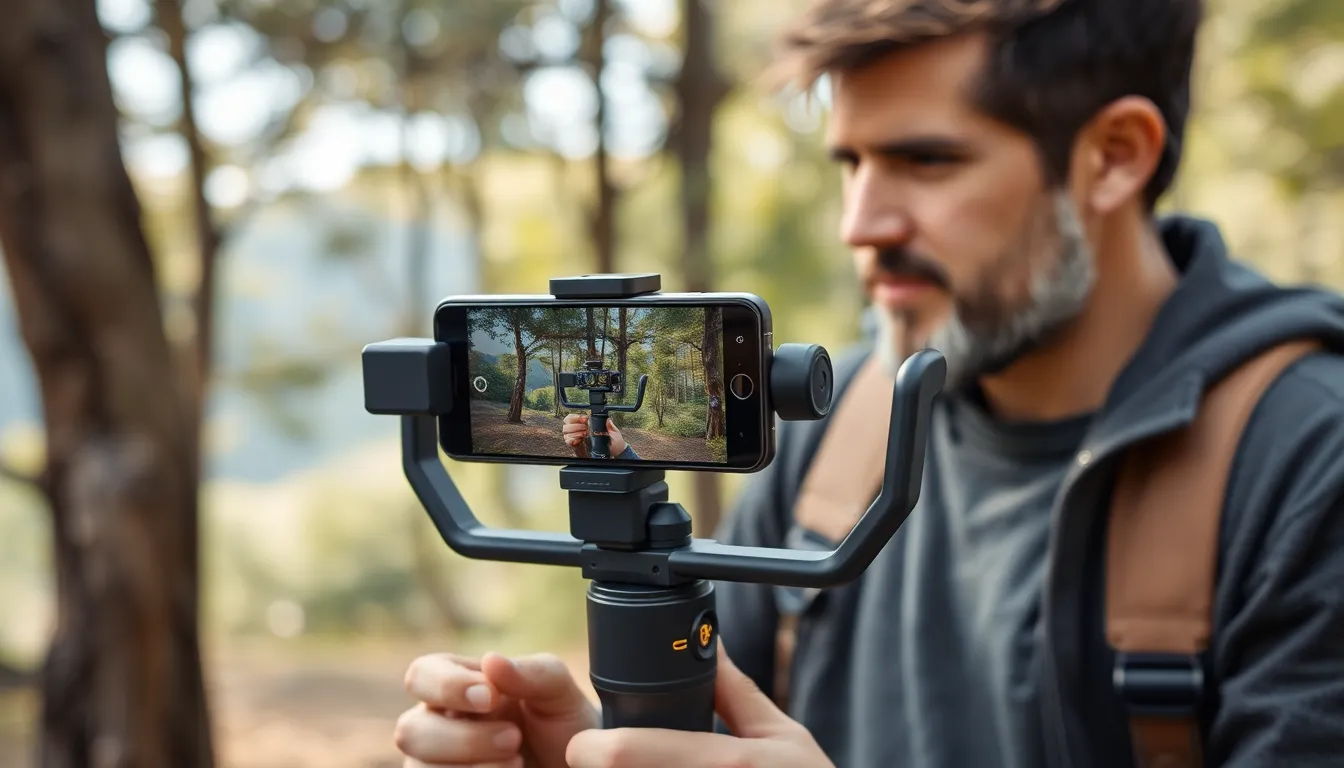Table of Contents
ToggleIn a world where everyone’s a filmmaker, smartphone gimbals are the unsung heroes of smooth shots and epic selfies. Imagine capturing your best moments without the dreaded shaky hands ruining your masterpiece. These nifty gadgets transform ordinary videos into cinematic experiences, making it easier than ever to unleash creativity.
Overview Of Smartphone Gimbals
Smartphone gimbals stabilize devices during recording, significantly reducing unwanted movement. These handheld tools enhance video quality and offer filmmakers creative freedom. With motors working in various directions, gimbals counteract natural shakes and jolts, creating a smoother viewing experience.
Users benefit from different gimbal modes that cater to specific filming needs, like follow mode, lock mode, and pan mode. Each mode enables unique camera movements, such as panning or tracking subjects smoothly. Many smartphone gimbals connect to mobile apps, providing advanced features. These apps may include templates for time-lapses, motion tracking, and editing tools.
Various smartphone gimbals exist in the market, with each designed for specific use cases. Lightweight options are ideal for travel, while more robust models offer extended battery life for lengthy shoots. Constructed with durable materials, gimbals withstand regular use, ensuring long-lasting performance.
Many filmmakers prefer gimbals due to their affordability compared to traditional camera stabilization systems. They’re user-friendly, making them accessible for both amateurs and professionals. Accessories like tripod mounts and phone holders further enhance functionality and versatility.
In terms of popularity, smartphone gimbals have gained traction in the social media content creation realm. Vloggers and influencers capitalize on smooth video quality to engage audiences. Overall, smartphone gimbals elevate mobile filmmaking, opening creative possibilities for users at all skill levels.
Types Of Smartphone Gimbals

Smartphone gimbals come in various types, each designed to meet different user needs. Understanding these types can help filmmakers and vloggers select the right tool for their projects.
Mechanical Gimbals
Mechanical gimbals utilize physical components to stabilize smartphones during filming. These devices rely on springs and counterweights, allowing for smooth camera movement without electronic assistance. Users appreciate mechanical gimbals for their simplicity and durability. They often feature adjustable arms, enabling users to customize balance according to their smartphone’s weight. Ideal for outdoor shoots or rough environments, mechanical options require no batteries or charging, making them convenient for extended use. Notably, the lack of electronic components results in lighter designs, enhancing portability for travel.
Electronic Gimbals
Electronic gimbals incorporate motors and sensors to provide advanced stabilization features. These devices can automatically adjust to various movements, resulting in remarkable smoothness even in dynamic shooting situations. Users benefit from features like follow mode or object tracking, enhancing creativity in video production. Many electronic gimbals connect to smartphone apps, enabling access to additional functions, such as time-lapse and panoramas. Often heavier than mechanical options, electronic gimbals might require battery management, but their versatility makes them a popular choice for serious filmmakers. Overall, they stand out as powerful tools in the evolving landscape of mobile videography.
Key Features To Consider
Examining key features of smartphone gimbals enhances understanding of their functionality. Each aspect contributes significantly to user experience and creative potential.
Stabilization Technology
Stabilization technology varies among smartphone gimbals and directly affects video quality. Electronic gimbals typically utilize motors and sensors to achieve advanced stabilization, resulting in smooth footage even during rapid movements. Mechanical gimbals, on the other hand, rely on physical components like springs and counterweights, offering simplicity and durability. Users should prioritize their shooting environment when selecting a stabilization type, as outdoor settings may benefit from the ruggedness of mechanical models while indoor shots often favor electronic options for added precision.
Battery Life
Battery life ranks high on the list of features to assess in smartphone gimbals. Most electronic gimbals offer operational times between 6 to 12 hours, depending on the model and usage intensity. Users engaging in extended shooting sessions should consider gimbals with removable batteries for convenient power management. Additionally, some models provide USB-C ports for faster charging, which can be a useful feature for on-the-go content creators. Knowing the battery life helps prevent interruptions during filming.
Customization Options
Customization options enhance creative control in smartphone gimbals. Many models feature adjustable settings for follow speed, tilt angles, and panning movements, allowing users to craft unique shots. Some advanced gimbals even include programmable modes that store preferred movement patterns, facilitating quick transitions between shots. Integrating mobile app connectivity further expands customization possibilities, enabling users to access additional features like automated tracking and time-lapse settings. Prioritizing these options can significantly improve filming versatility.
Popular Smartphone Gimbal Models
Smartphone gimbals come in various models, each designed to meet unique filming needs. Below are two popular options that users frequently choose.
Model A
The DJI OM 5 stands out as a highly rated smartphone gimbal. Users appreciate its lightweight design, which weighs just 390 grams, making it ideal for travel. With a maximum battery life of 6.4 hours, filmmakers enjoy extended shooting without interruption. Object tracking features enable smooth movement while capturing subjects, adding a professional touch to home videos. Additionally, its foldable design simplifies portability, fitting easily into bags or pockets. The accompanying DJI Mimo app enhances functionality, offering smart templates and editing tools to streamline the post-production process.
Model B
The Zhiyun Smooth 4 is another excellent choice for capturing stunning footage. Weighing approximately 450 grams, this gimbal provides robust stability for various filming conditions. Users benefit from a battery life that can offer up to 12 hours of continuous use, making it suitable for long shoots. A focus pull and zoom capability allows for dynamic creativity, enabling filmmakers to adjust focus seamlessly during filming. Furthermore, its ergonomic design enhances comfort during extended use. Compatibility with the ZY Play app adds advanced features, including time-lapse and panorama modes, further expanding creative possibilities.
Smartphone gimbals have revolutionized the way users approach mobile filmmaking. By providing stability and enhancing video quality they empower creators to capture stunning footage effortlessly. With a variety of options available there’s a gimbal suited for every need whether for casual vlogging or professional projects.
The combination of advanced stabilization technology and creative features allows filmmakers to explore new possibilities. As these devices continue to evolve they will undoubtedly play a crucial role in shaping the future of content creation. Embracing a smartphone gimbal can elevate any filming experience transforming ordinary moments into extraordinary visual stories.




